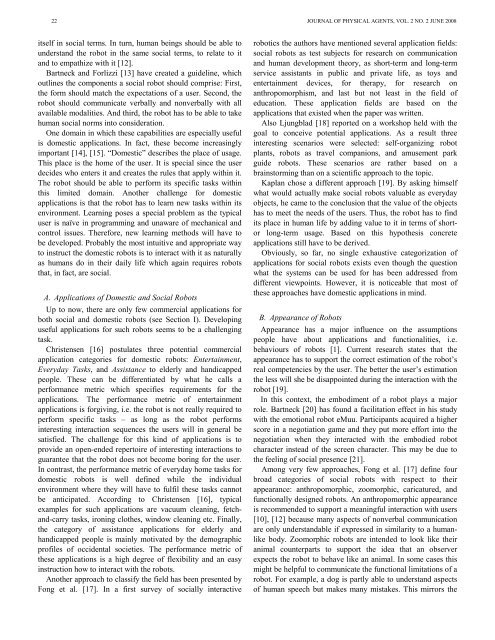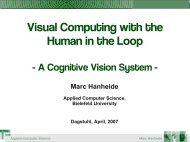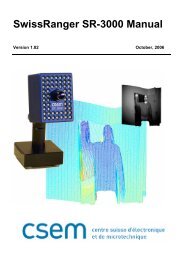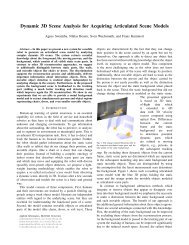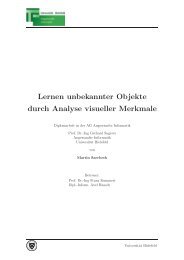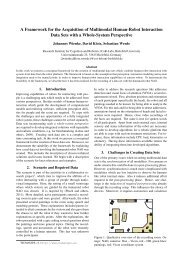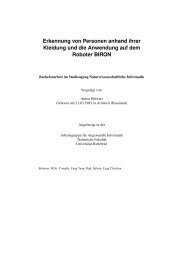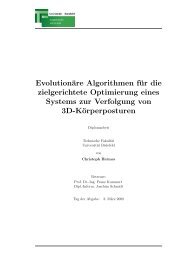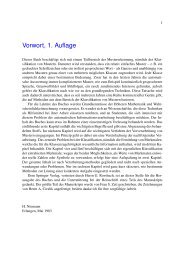Domestic Applications for Social Robots - Journal of Physical Agents
Domestic Applications for Social Robots - Journal of Physical Agents
Domestic Applications for Social Robots - Journal of Physical Agents
You also want an ePaper? Increase the reach of your titles
YUMPU automatically turns print PDFs into web optimized ePapers that Google loves.
22 JOURNAL OF PHYSICAL AGENTS, VOL. 2 NO. 2 JUNE 2008<br />
itself in social terms. In turn, human beings should be able to<br />
understand the robot in the same social terms, to relate to it<br />
and to empathize with it [12].<br />
Bartneck and Forlizzi [13] have created a guideline, which<br />
outlines the components a social robot should comprise: First,<br />
the <strong>for</strong>m should match the expectations <strong>of</strong> a user. Second, the<br />
robot should communicate verbally and nonverbally with all<br />
available modalities. And third, the robot has to be able to take<br />
human social norms into consideration.<br />
One domain in which these capabilities are especially useful<br />
is domestic applications. In fact, these become increasingly<br />
important [14], [15]. “<strong>Domestic</strong>” describes the place <strong>of</strong> usage.<br />
This place is the home <strong>of</strong> the user. It is special since the user<br />
decides who enters it and creates the rules that apply within it.<br />
The robot should be able to per<strong>for</strong>m its specific tasks within<br />
this limited domain. Another challenge <strong>for</strong> domestic<br />
applications is that the robot has to learn new tasks within its<br />
environment. Learning poses a special problem as the typical<br />
user is naïve in programming and unaware <strong>of</strong> mechanical and<br />
control issues. There<strong>for</strong>e, new learning methods will have to<br />
be developed. Probably the most intuitive and appropriate way<br />
to instruct the domestic robots is to interact with it as naturally<br />
as humans do in their daily life which again requires robots<br />
that, in fact, are social.<br />
A. <strong>Applications</strong> <strong>of</strong> <strong>Domestic</strong> and <strong>Social</strong> <strong>Robots</strong><br />
Up to now, there are only few commercial applications <strong>for</strong><br />
both social and domestic robots (see Section I). Developing<br />
useful applications <strong>for</strong> such robots seems to be a challenging<br />
task.<br />
Christensen [16] postulates three potential commercial<br />
application categories <strong>for</strong> domestic robots: Entertainment,<br />
Everyday Tasks, and Assistance to elderly and handicapped<br />
people. These can be differentiated by what he calls a<br />
per<strong>for</strong>mance metric which specifies requirements <strong>for</strong> the<br />
applications. The per<strong>for</strong>mance metric <strong>of</strong> entertainment<br />
applications is <strong>for</strong>giving, i.e. the robot is not really required to<br />
per<strong>for</strong>m specific tasks – as long as the robot per<strong>for</strong>ms<br />
interesting interaction sequences the users will in general be<br />
satisfied. The challenge <strong>for</strong> this kind <strong>of</strong> applications is to<br />
provide an open-ended repertoire <strong>of</strong> interesting interactions to<br />
guarantee that the robot does not become boring <strong>for</strong> the user.<br />
In contrast, the per<strong>for</strong>mance metric <strong>of</strong> everyday home tasks <strong>for</strong><br />
domestic robots is well defined while the individual<br />
environment where they will have to fulfil these tasks cannot<br />
be anticipated. According to Christensen [16], typical<br />
examples <strong>for</strong> such applications are vacuum cleaning, fetchand-carry<br />
tasks, ironing clothes, window cleaning etc. Finally,<br />
the category <strong>of</strong> assistance applications <strong>for</strong> elderly and<br />
handicapped people is mainly motivated by the demographic<br />
pr<strong>of</strong>iles <strong>of</strong> occidental societies. The per<strong>for</strong>mance metric <strong>of</strong><br />
these applications is a high degree <strong>of</strong> flexibility and an easy<br />
instruction how to interact with the robots.<br />
Another approach to classify the field has been presented by<br />
Fong et al. [17]. In a first survey <strong>of</strong> socially interactive<br />
robotics the authors have mentioned several application fields:<br />
social robots as test subjects <strong>for</strong> research on communication<br />
and human development theory, as short-term and long-term<br />
service assistants in public and private life, as toys and<br />
entertainment devices, <strong>for</strong> therapy, <strong>for</strong> research on<br />
anthropomorphism, and last but not least in the field <strong>of</strong><br />
education. These application fields are based on the<br />
applications that existed when the paper was written.<br />
Also Ljungblad [18] reported on a workshop held with the<br />
goal to conceive potential applications. As a result three<br />
interesting scenarios were selected: self-organizing robot<br />
plants, robots as travel companions, and amusement park<br />
guide robots. These scenarios are rather based on a<br />
brainstorming than on a scientific approach to the topic.<br />
Kaplan chose a different approach [19]. By asking himself<br />
what would actually make social robots valuable as everyday<br />
objects, he came to the conclusion that the value <strong>of</strong> the objects<br />
has to meet the needs <strong>of</strong> the users. Thus, the robot has to find<br />
its place in human life by adding value to it in terms <strong>of</strong> short-<br />
or long-term usage. Based on this hypothesis concrete<br />
applications still have to be derived.<br />
Obviously, so far, no single exhaustive categorization <strong>of</strong><br />
applications <strong>for</strong> social robots exists even though the question<br />
what the systems can be used <strong>for</strong> has been addressed from<br />
different viewpoints. However, it is noticeable that most <strong>of</strong><br />
these approaches have domestic applications in mind.<br />
B. Appearance <strong>of</strong> <strong>Robots</strong><br />
Appearance has a major influence on the assumptions<br />
people have about applications and functionalities, i.e.<br />
behaviours <strong>of</strong> robots [1]. Current research states that the<br />
appearance has to support the correct estimation <strong>of</strong> the robot’s<br />
real competencies by the user. The better the user’s estimation<br />
the less will she be disappointed during the interaction with the<br />
robot [19].<br />
In this context, the embodiment <strong>of</strong> a robot plays a major<br />
role. Bartneck [20] has found a facilitation effect in his study<br />
with the emotional robot eMuu. Participants acquired a higher<br />
score in a negotiation game and they put more ef<strong>for</strong>t into the<br />
negotiation when they interacted with the embodied robot<br />
character instead <strong>of</strong> the screen character. This may be due to<br />
the feeling <strong>of</strong> social presence [21].<br />
Among very few approaches, Fong et al. [17] define four<br />
broad categories <strong>of</strong> social robots with respect to their<br />
appearance: anthropomorphic, zoomorphic, caricatured, and<br />
functionally designed robots. An anthropomorphic appearance<br />
is recommended to support a meaningful interaction with users<br />
[10], [12] because many aspects <strong>of</strong> nonverbal communication<br />
are only understandable if expressed in similarity to a humanlike<br />
body. Zoomorphic robots are intended to look like their<br />
animal counterparts to support the idea that an observer<br />
expects the robot to behave like an animal. In some cases this<br />
might be helpful to communicate the functional limitations <strong>of</strong> a<br />
robot. For example, a dog is partly able to understand aspects<br />
<strong>of</strong> human speech but makes many mistakes. This mirrors the


